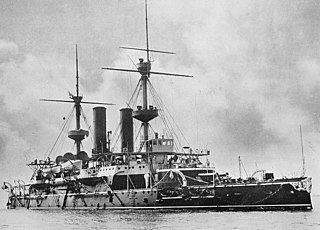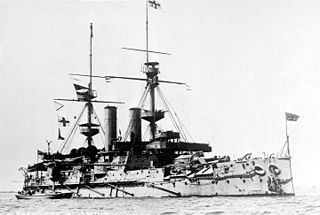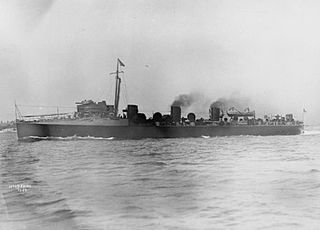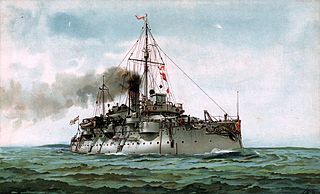
USS Indiana was the lead ship of her class and the first battleship in the United States Navy comparable to foreign battleships of the time. Authorized in 1890 and commissioned five years later, she was a small battleship, though with heavy armor and ordnance. The ship also pioneered the use of an intermediate battery. She was designed for coastal defense and as a result, her decks were not safe from high waves on the open ocean.

USS Massachusetts was an Indiana-class, pre-dreadnought battleship and the second United States Navy ship comparable to foreign battleships of its time. Authorized in 1890, and commissioned six years later, she was a small battleship, though with heavy armor and ordnance. The ship class also pioneered the use of an intermediate battery. She was designed for coastal defense and as a result, her decks were not safe from high waves on the open ocean.

HMAS Encounter was a second-class protected cruiser of the Challenger class operated by the Royal Navy (RN) and Royal Australian Navy (RAN). She was built by HM Dockyard Devonport and completed at the end of 1905.

HMS Devastation was the first of two Devastation-class mastless turret ships built for the Royal Navy. This was the first class of ocean-going capital ship that did not carry sails, and the first whose entire main armament was mounted on top of the hull rather than inside it.

HMS Hood was a modified Royal Sovereign-class pre-dreadnought battleship built for the Royal Navy in the early 1890s. She differed from the other ships of the class in that she had cylindrical gun turrets instead of barbettes and a lower freeboard. She served most of her active career in the Mediterranean Sea, where her low freeboard was less of a disadvantage. The ship was placed in reserve in 1907 and later became the receiving ship at Queenstown, Ireland. Hood was used in the development of anti-torpedo bulges in 1913 and was scuttled in late 1914 to act as a blockship across the southern entrance of Portland Harbour after the start of World War I.

HMAS Pioneer was a Pelorus-class protected cruiser built for the Royal Navy at the end of the 19th century. She was transferred to the fledgling Royal Australian Navy (RAN) in 1912. During World War I, the cruiser captured two German merchant ships, and was involved in the East African Campaign, including the blockade of the cruiser SMS Königsberg and a bombardment of Dar-es-Salaam. She returned to Australia in late 1916 and was decommissioned. Pioneer was used as an accommodation ship for the following six years, then was stripped down and sold off by 1926. The cruiser was scuttled outside Sydney Heads in 1931.

The third USS Dale (DD-290) was a Clemson-class destroyer in the United States Navy. She was named for Richard Dale.

HMS Bat was a Palmer-built three funnel, 30 knot torpedo boat destroyer ordered by the Royal Navy under the 1895 – 1896 Naval Estimates. She was the third ship to carry this name since it was introduced in 1815 for a revenue cutter in service until 1848. Bat was classified along with similar vessels as a C-class destroyer in 1913.

HMS Tamar was the name for the British Royal Navy's base in Hong Kong from 1897 to 1997. It took its name from HMS Tamar, a ship that was used as the base until replaced by buildings ashore.

The Powerful class were a pair of first-class protected cruisers built for the Royal Navy (RN) in the 1890s, designed to hunt down enemy commerce raiders. Both ships served on the China Station and participated in the Second Boer War of 1899–1900. Terrible went on to help suppress the Boxer Rebellion a few months later. Powerful served as the flagship of the Australia Station in 1905–1912; shortly after her return home, she became a training ship and remained in that role until she was sold for scrap in 1929. Terrible was mostly in reserve after she returned home in 1902 and was often used as an accommodation ship. During the First World War she was disarmed and made one voyage as a troop transport in 1915. The ship became a depot ship when she returned home and then became a training ship in 1918. Terrible was sold for scrap in 1932.

HMS London was the lead ship of the London class of pre-dreadnought battleships built for the British Royal Navy. The Londons were near repeats of the preceding Formidable-class battleships, but with modified armour protection. The ship was laid down in December 1898, was launched in September 1899, and was completed in June 1902. Commissioned the same month, she served with the Mediterranean Fleet until early 1907. She was assigned to the Nore Division of the Home Fleet for nearly a year before transferring to the Channel Fleet. Rendered obsolete with the emergence of the new dreadnoughts in late 1906, she underwent an extensive refit in 1909, after which she served with the Atlantic Fleet. She was assigned to the Second Home Fleet in 1912 as part of the 5th Battle Squadron, and was temporarily fitted with a makeshift ramp for experiments with naval aircraft until 1913.

HMS Royal Sovereign was the lead ship of the seven ships in her class of pre-dreadnought battleships built for the Royal Navy in the 1890s. The ship was commissioned in 1892 and served as the flagship of the Channel Fleet for the next five years. She was transferred to the Mediterranean Fleet in 1897 and returned home in 1902, and was briefly assigned as a coast guard ship before she began a lengthy refit in 1903–1904. Royal Sovereign was reduced to reserve in 1905 and was taken out of service in 1909. The ship was sold for scrap four years later and subsequently broken up in Italy.

HMS Empress of India was one of seven Royal Sovereign-class pre-dreadnought battleships built for the Royal Navy during the 1890s. The ship was commissioned in 1893 and served as the flagship of the second-in-command of the Channel Fleet for two years. She was transferred to the Mediterranean Fleet in 1897, during which time Empress of India was assigned to the International Squadron blockading Crete during the uprising there. She returned home in 1901 and was briefly assigned as a coast guard ship in Ireland before she became the second flagship of the Home Fleet. The ship was reduced to reserve in 1905 and accidentally collided with the submarine HMS A10 the following year. Empress of India was taken out of service in early 1912 and accidentally struck a German sailing ship while under tow. She was sunk as a target ship in 1913.

HMS Gipsy was a Fairfield-built three-funnel, 30 knot torpedo boat destroyer ordered by the Royal Navy under the 1896 – 1897 Naval Estimates. She was the fourth ship to carry this name. Designated as a C-class destroyer in 1913, Gipsy served on patrol in the First World War operating out of Dover. She was sold for breaking in 1921.
HMS Leopard was a Vickers three funnel - 30 knot destroyer ordered by the Royal Navy under the 1895 – 1896 Naval Estimates. She was the ninth ship to carry this name since it was introduced in 1635 for a 34-gun ship, captured by the Dutch in 1653.

Saga (嵯峨) was a river gunboat of the Imperial Japanese Navy, that operated on the Yangtze River and in coastal waters of China during the 1930s, and during the Second Sino-Japanese War and World War II.

The Arrogant-class cruiser was a class of four protected cruisers built for the British Royal Navy at the end of the 1890s. One ship, HMS Gladiator, was lost following a collision with a merchant ship in 1908, while HMS Vindictive saw active service in the First World War, taking part in the Zeebrugge Raid in April 1918 before being sunk as a blockship during the Second Ostend Raid in May 1918.

SMS Frithjof was the third vessel of the six-member Siegfried class of coastal defense ships built for the German Imperial Navy. Her sister ships were Siegfried, Beowulf, Heimdall, Hildebrand, and Hagen. Frithjof was built by the AG Weser shipyard between 1890 and 1893, and was armed with a main battery of three 24-centimeter (9.4 in) guns. She served in the German fleet throughout the 1890s and was rebuilt in 1900 - 1902. She served in the VI Battle Squadron after the outbreak of World War I in August 1914, but saw no action. Frithjof was demobilized in 1915 and used as a barracks ship thereafter. She was rebuilt as a merchant ship in 1923 and served in this capacity until she was broken up for scrap in 1930.

HMS Albatross was an experimental torpedo boat destroyer of the Royal Navy authorised under the 1896–97 Naval Estimates and built by John I. Thornycroft & Company of Chiswick on the River Thames. She was contracted to be faster, larger and more powerful than existing designs.
HMS Vivid was an iron screw yacht purchased from civilian service in 1891, where she had been named SS Capercailzie. She became the Devonport base ship and flagship in 1893 and was also used as the yacht for the Commander-in-Chief, Plymouth and was sold in 1912, later being wrecked in 1913.




















